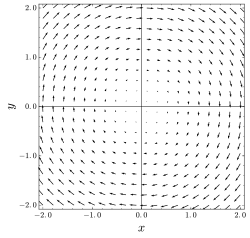Solenoidal vector field: Difference between revisions
Trevayne08 (talk | contribs) m →Properties: - extraneous / misplaced "only" (removed) |
The discussion about the properties of the flux lines has been improved. A reference has been added. Tags: Reverted Visual edit |
||
| Line 2: | Line 2: | ||
In [[vector calculus]] a '''solenoidal vector field''' (also known as an '''incompressible vector field''', a '''divergence-free vector field''', or a [[Helmholtz decomposition#Longitudinal and transverse fields| '''transverse vector field''']]) is a [[vector field]] '''v''' with [[divergence]] zero at all points in the field: |
In [[vector calculus]] a '''solenoidal vector field''' (also known as an '''incompressible vector field''', a '''divergence-free vector field''', or a [[Helmholtz decomposition#Longitudinal and transverse fields| '''transverse vector field''']]) is a [[vector field]] '''v''' with [[divergence]] zero at all points in the field: |
||
:<math> \nabla \cdot \mathbf{v} = 0.\, </math> |
:<math> \nabla \cdot \mathbf{v} = 0.\, </math> |
||
A common way of expressing this property is to say that the field has no sources or sinks. |
A common way of expressing this property is to say that the field has no sources or sinks. However, often this statement is misunderstood and leads to the conclusion that the [[field line]]s of a solenoidal field are either closed loops or end at infinity. Actually, these properties are sufficient, but not strictly required, to satisfy the equation above<ref>{{Cite journal|last=Zilberti|first=Luca|date=2017|title=The Misconception of Closed Magnetic Flux Lines|url=http://ieeexplore.ieee.org/document/7911292/|journal=IEEE Magnetics Letters|volume=8|pages=1–5|doi=10.1109/LMAG.2017.2698038|issn=1949-307X}}</ref>. |
||
==Properties== |
==Properties== |
||
Revision as of 14:43, 1 February 2021

In vector calculus a solenoidal vector field (also known as an incompressible vector field, a divergence-free vector field, or a transverse vector field) is a vector field v with divergence zero at all points in the field:
A common way of expressing this property is to say that the field has no sources or sinks. However, often this statement is misunderstood and leads to the conclusion that the field lines of a solenoidal field are either closed loops or end at infinity. Actually, these properties are sufficient, but not strictly required, to satisfy the equation above[1].
Properties
The divergence theorem gives an equivalent integral definition of a solenoidal field; namely that for any closed surface, the net total flux through the surface must be zero:
-
 ,
,
where is the outward normal to each surface element.
The fundamental theorem of vector calculus states that any vector field can be expressed as the sum of an irrotational and a solenoidal field. The condition of zero divergence is satisfied whenever a vector field v has only a vector potential component, because the definition of the vector potential A as:
automatically results in the identity (as can be shown, for example, using Cartesian coordinates):
The converse also holds: for any solenoidal v there exists a vector potential A such that (Strictly speaking, this holds subject to certain technical conditions on v, see Helmholtz decomposition.)
Etymology
Solenoidal has its origin in the Greek word for solenoid, which is σωληνοειδές (sōlēnoeidēs) meaning pipe-shaped, from σωλην (sōlēn) or pipe. In the present context of solenoidal it means constrained as if in a pipe, so with a fixed volume.
Examples
- The magnetic field B (see Maxwell's equations)
- The velocity field of an incompressible fluid flow
- The vorticity field
- The electric field E in neutral regions ();
- The current density J where the charge density is unvarying, .
- The magnetic vector potential A in Coulomb gauge
See also
References
- Aris, Rutherford (1989), Vectors, tensors, and the basic equations of fluid mechanics, Dover, ISBN 0-486-66110-5
- ^ Zilberti, Luca (2017). "The Misconception of Closed Magnetic Flux Lines". IEEE Magnetics Letters. 8: 1–5. doi:10.1109/LMAG.2017.2698038. ISSN 1949-307X.









